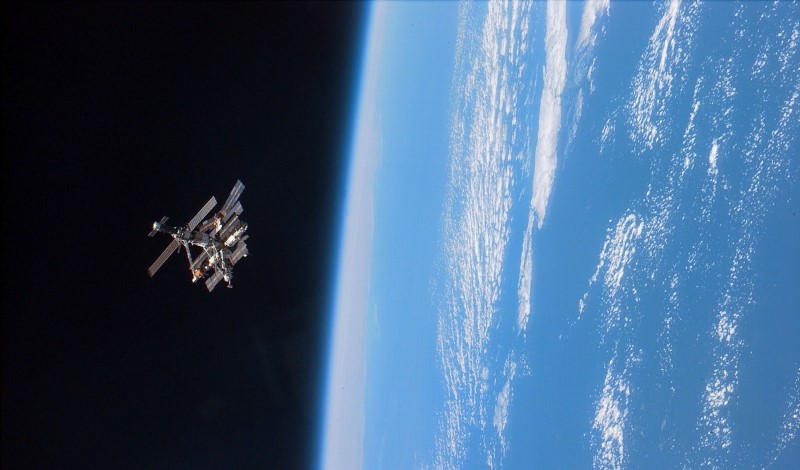
Scholars discuss regulatory methods to reduce threats posed by satellite debris.
The movie Gravity, starring Sandra Bullock and George Clooney, depicts astronauts who become stranded in space after debris collides with and destroys their shuttle. Although it was dramatized for Hollywood, the cascade effect of debris collisions is a serious concern for astronomers.
The chain reaction of debris depicted in Gravity was envisioned in 1978 by U.S. astrophysicist Donald Kessler, and is now known as Kessler Syndrome. The term describes a scenario in which colliding satellites in low Earth orbit (LEO) break apart and collide with other satellites to create a cascading effect that fills LEO with debris. Kessler speculated that the likelihood of collisions would increase as more satellites were put into orbit, and that such collisions would eventually create so much debris that humanity’s access to space would be severely limited.
Currently, more than 10,000 active satellites are orbiting Earth, approximately 80 percent of which are in LEO. The number of satellites surrounding Earth is expected to increase to 60,000 by 2030 due to the introduction of mega-constellations, such as Starlink, which are independent networks of thousands of satellites spread out across LEO. Satellite collisions are rare, but their frequency has increased in recent years, with additional collisions and explosions leading to significantly more debris.
Scientists fear that a Kessler Syndrome scenario could threaten to destroy all satellites in LEO, and with them the internet and all satellite-dependent communication.
Resultantly, scientists and regulators around the world are proposing preventative measures. For example, the Space Safety Coalition released a series of proposed voluntary guidelines and best practices for companies and agencies to mitigate the worsening risk of Kessler Syndrome, such as promptly disposing of rocket upper stages to reduce their chances of colliding with other debris. In addition, space agencies such as the National Aeronautics and Space Administration (NASA) have created their own internal guidelines for limiting orbital debris.
Furthermore, The Federal Communications Commission (FCC) now requires that all licensed satellites limit their lifetime to five years and have a plan to deorbit the satellite at the end of its lifetime. In addition, the FCC has also created a new agency subdivision known as the Space Bureau to regulate satellites and debris.
Many scientists, however, argue that more must be done to keep LEO clean, safe, and usable for the future, as the number of collisions is increasing despite the current regulatory scheme.
In this week’s Saturday Seminar, scholars examine potential regulations to prevent the cascading effects of Kessler Syndrome.
- In an article in Visions for Sustainability, the independent Spanish scholar Adrià Harillo Pla argues that international law’s failure to assign responsibility for space debris could make a Kessler Syndrome scenario more likely. Pla explains that under international law, governments are not legally responsible for debris that accumulates above the Karman Line, which is the commonly accepted boundary between Earth’s atmosphere and outer space. The author analogizes this situation to other environmental challenges in which no single government can be held responsible for crises, such as in the Arctic. In response, Pla urges governments and private stakeholders to collaborate in the creation of guidelines to assign responsibility for management of space debris.
- Debris from rockets launched into space often falls back to Earth, Michael Byers of Canada’s University of British Columbia and several coauthors explain in an article in Nature Astronomy. The Byers team argues that current regulations are insufficient to protect against the risk of casualties caused by this falling debris, a risk that disproportionately affects countries in the Global South. Byers and his coauthors explain that modern technology can control where debris falls and eliminate much of the casualty risk, but that many launch providers decline to implement this safety feature. The Byers team urges countries in the Global South to push for international mandates to require such technology be implemented for all rocket launches.
- To mitigate dangers posed by space debris, researcherToyah Höher of the University of Amsterdam proposes a two-pronged political and economic approach in an article in the Amsterdam Review of European Affairs. Höher argues that any viable solution to the problem of space debris must include a political agreement on assigning responsibility for space debris so that it can be regulated. In addition, Höher contends that such a political arrangement must be supplemented with economic policies that spur beneficial innovation by private actors. Without further action, the Kessler Syndrome’s socio-economic impacts may cause a loss of internet and communication services, a stalling of Earth science and climate research, and threats to human lives and property, Höher warns.
- In a NASA report, Small Spacecraft Systems Virtual Institute Director Bruce Yost and co-authors discuss a variety of technologies that could be used to deorbit space debris. The authors split technologies into two groups: passive and active systems. Satellites with passive systems deorbit themselves after a period of time through inherent design features. Active removal systems, conversely, consist of separate spacecraft that are launched to take inactive satellites out of orbit, the Bruce and coauthors explain. The authors also note that to reduce debris, companies are designing spacecraft with a variety of removal mechanisms, such as arms that can grab and carry satellites, magnetic capture devices, and water plasma propulsion systems.
- Scholars John L. Crassidis and Amrith Mariappan of the University at Buffalo discuss short and long term debris mitigation strategies in an article in Frontiers. In the short-term, Crassidis and Mariappan recommend the development and deployment of active deorbiting systems that prioritize hazardous debris to bring into the Earth’s atmosphere to burn on reentry. The scholars caution, however, that the burning of the aluminum used in spacecraft could negatively alter regional weather patterns and damage the ozone. To prevent these negative effects, the researchers suggest that space debris should be recycled and repurposed in space as an environmentally sustainable long-term solution.
- The risk of space debris endangering astronauts, increasing costs of space missions, or causing international conflict is rapidly increasing, Dylan Houle warns in a student note in the California Law Review. Houle explains that governments have only recently begun to recognize these risks. Consequently, international safety guidelines are often ignored in dangerous ways by spacefaring nations. Houle argues that one potential solution is to create an international regulatory body with the power to create and enforce international standards. Houle proposes that this agency would determine what debris should be removed, register new satellites launched into space, and collect a registration fee to be used to fund experiments and test debris removal technology.
The Saturday Seminar is a weekly feature that aims to put into written form the kind of content that would be conveyed in a live seminar involving regulatory experts. Each week, The Regulatory Review publishes a brief overview of a selected regulatory topic and then distills recent research and scholarly writing on that topic.



